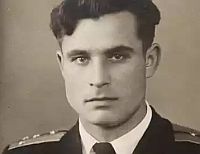 Fifty two years ago today, the world came perilously close to being destroyed in a nuclear World War III. Fortunately, one brave Soviet naval officer stood in the way.
Fifty two years ago today, the world came perilously close to being destroyed in a nuclear World War III. Fortunately, one brave Soviet naval officer stood in the way.
Imagine — a Soviet submarine is trapped by an American destroyer at the height of the Cuban missile crisis. The Soviet sub commander has not been in communication with Moscow in over a week. He does not know if the world is at peace or at war. Depth charges are exploding around the stricken Soviet sub. The temperature inside the submarine has risen above 100 degrees. Unknown to the Americans, the submarine commander has a new and terrible weapon at his disposal, a nuclear torpedo that could vaporize the destroyer and most of the American fleet. Certain that his ship is under attack, the submarine commander wants to fire the nuclear torpedo. Given everything else that is going on on the surface, that launch would likely start World War III. Only one man stood in the way of potential global nuclear annihilation, the Soviet flotilla commander, Vasili Arkhipov.
This sounds like a movie script and yet, it indeed happened. On October 27, 1962, at the height of Cuban missle crisis, the world came perilously close to a nuclear Armageddon. Were it not for the cool head of Vasili Arkhipov, flotilla commander and second-in-command of the nuclear-armed submarine B-59, a nuclear World War III may have broken out. Thomas Blanton, the former director of the US National Security Archive, said, “Vasili Arkhipov saved the world.”
On October 1, 1962, a flotilla of four Soviet Foxtrot-class diesel-electric submarines sailed for Cuba, each carrying a single nuclear torpedo. The torpedo warheads were comparable in power to the atomic bomb dropped on Hiroshima during World War II. While the submarines are still in the Atlantic, the subs were ordered to standby in the Sargasso Sea before proceeding to Cuba.
In middle October, the United States had become aware that Soviet nuclear missiles were being transported and made ready in Cuba. The US announced a “quarantine” of Cuba and moved significant naval and air forces to the region. On October 27th, the US Navy located the Soviet submarine B59, outside the designated “quarantine area.”
The Americans on the Fletcher class destroyer, USS Cony, begin dropping practice depth charges in an attempt to force the submarine to the surface. The Russians, however, thought that they could be under attack and prepared the nuclear torpedo. Because they had been out of communication with Russia but could hear talk of war on Miami radio, the submariners did not know whether or not the two nations were already at war. If the torpedo had been launched and vaporized the US destroyer, it is very likely that the US would have responded with nuclear weapons, which could have resulted in an all-out nuclear war and the mutual annihilation of both the United States and the Soviet Union.
Submarine commander Valentin Savitsky wanted to fire the torpedo. Fortunately, Captain Vasili Arkhipov, while second in command on the B59, was the overall commander of the four submarine flotilla with the power to veto the use of the weapon. Against Savitsky’s objections, Arkhipov prevented the firing of the nuclear torpedo. The submarine surfaced, and, as it was in international waters beyond the American blockade zone, was allowed to proceed. The Americans never knew that the Soviet submarine was armed with a nuclear weapon or how close they and the world came to destruction.
Arkhipov continued in Soviet Navy service, commanding submarines and later submarine squadrons. He was promoted to rear admiral in 1975 and became head of the Kirov Naval Academy. Arkhipov was promoted to vice admiral in 1981 and retired in the mid-1980s. In 1961, a year prior to his stopping the use of the nuclear torpedo on the B59, Arkhipov had been exposed to high levels of radiation in a casualty in the nuclear-powered submarine K19. That exposure eventually contributed to his death in 1998 of kidney cancer.

Probably a more frightening story than anything you’ll hear on Halloween!
Pingback: RAILDATE – your free weekly guide to what’s happening, what’s new and what’s on.(Courtesy: Howard Sprenger) – Rail Tube